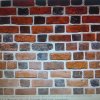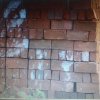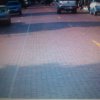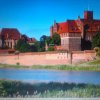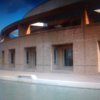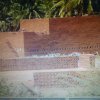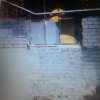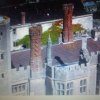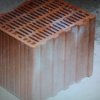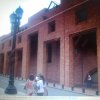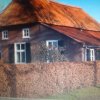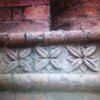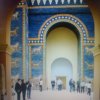Project
Makana brick how bricks are made
Formed in 1994, Makana Brick has
grown to become one of the largest clay brick suppliers in the region,
and a pillar of its local community. After more than R70 million worth
of investment into infrastructure, Makana Brick now boasts one of the
most technologically advanced clay brick plants in the country,
producing a full range of clay brick products, including face bricks,
stock bricks and pavers. The world class facilities have resulted in
Makana Brick being able to produce high volumes of the best quality clay
bricks utilizing a fully integrated transport system, backed up through
a dynamic sales team and a host of accredited partners across the
region.
Clay bricks are the strongest and
most durable building material known to man. The durability of clay
bricks is almost impossible to match. The products are of the earth,
forged by entirely natural elements, and fired at temperatures over 1000
C, resulting in a final product that will last for decades, generations
and through centuries. The strength of the product results in minimal
maintenance over the life of a building, and in the case of face brick
buildings, no maintenance is required to the walls, making clay brick
the most cost effective building solution. The durability of clay bricks
is almost impossible to match.
In addition to this, clay bricks are
arguably the most energy efficient building material available. The
thermal properties of clay bricks allow them to make optimal use of
energy, which results in the end user consuming less electricity through
temperature control. Being a major part of the community, we recognize
that the future of the planet is dependent on our actions today, which
is why we are proud that technically advanced Makana Brick factory also
lends itself to a cleaner, more streamlines manufacturing process, with
less wastage.
But its not all about strength and being
environmentally friendly. Clay face brick exists in a variety of colors and shading, exhibiting an ageless beauty. Very few things in
life never go out of style or fashion, and clay brick is one of those
things. They are part of our background.
A brick is a block, or a single unit of a Ceramic material used in masonry construction, usually stacked together, or laid using various kinds of Mortar to hold the bricks together and make a permanent structure.Bricks are typically produced in common or standard sizes in bulk
quantities. They have been regarded as one of the longest lasting and
stronger used throughout history.
The oldest discovered bricks, originally made from shaped mud and dating to before 7500 B.C.
[more]
CHINA-In Pre-Modern China brick-making was the job of a lowly and unskilled artisan, but a kiln master was respected as a step above the former.Early traces of bricks were found in a ruin site in
in 2009 dated back about 3800 years ago. Before this discovery, it is
widely believed that bricks appeared about 3000 years ago in the. These bricks are the earliest bricks discovered that were made by a fired process.
The .. kiln master had to make sure that the temperature inside the
kiln stayed at a level that caused the clay to shimmer with the color
of gold or silver. He also had to know when to quench the kiln
with water so as to produce the surface glaze. To anonymous laborers
fell the less skilled stages of brick production: mixing clay and water,
driving oxen over the mixture to trample it into a thick paste,
scooping the paste into standardized wooden frames (to produce a brick
roughly 42 cm
long, 20 cm wide, and 10 cm thick), smoothing the surfaces with a
wire-strung bow, removing them from the frames, printing the fronts and
backs with stamps that indicated where the bricks came from and who made
them, loading the kilns with fuel (likelier wood than coal), stacking
the bricks in the kiln, removing them to cool while the kilns were still
hot, and bundling them into pallets for transportation. It was hot,
filthy work. Europe-The oldest domestic bricks were found in Greece. In the 12th century, bricks from Northern-Western.During the Renaissance visible brick walls were unpopular and the Brickwork was often covered with plaster..
It was only during the mid-18th century that visible brick walls
regained some degree of popularity.Bricks were often used for reasons of speed and economy, even in areas where stone was available. In Victorian London the bright red brick was chosen to make buildings visible in the heavy fog that caused transport problems.
[more]
Bricks are primarily made of clay materials, or ground up shale, with other materials and binders added.Bricks" for building may be made from clay,shale, soft slate, calcium silcate
concrete, or shaped from quarried stone. However, true bricks are
ceramic, and therefore created by the action of heat and cooling.
What is Clay-
Clay is the most common material, with modern clay bricks formed in one of three processes - soft mud, dry press, or extruded.
Normally, brick contains the following ingredients
- Silica (sand) - 50% to 60% by weight
- Alumina (clay) - 20% to 30% by weight
- Lime - 2 to 5% by weight
- Iron oxide - 5 to 6% (not greater than 7%) by weight
- Magnesia - less than 1% by weight
[more]
What are the different types of bricks?Bricks are rectangular shaped blocks of hard material, usually clay, that are laid in rows and columns to build structures. There are different varieties of bricks depending on their role in the construction process. Firstly there are three ways that bricks can be shaped: Solid These are bricks that are flat on all sides, a perfect rectangle. Frogged These
have an indented, smaller rectangle on the top. Frogged bricks should
always be laid with the frog at the top so that the load is spread
equally across the width of the brick, not just across the edges. Perforated A perforated brick has holes through from top to bottom.
Mud Bricks
The soft mud method is the most common, as it is the most economical.
It starts with the raw clay, preferably in a mix with 25-30% sand to
reduce shrinkage. The clay is first ground and mixed with water to the
desired consistency. The clay is then pressed into steel moulds with a hydraulic press. The shaped clay is then fired ("burned") at 900-1000 ðC to achieve strength. Dry pressed bricksThe dry press method is similar to mud brick but starts with a much
thicker clay mix, so it forms more accurate, sharper-edged bricks. The
greater force in pressing and the longer burn make this method more
expensive.
Extruded bricks
For extruded bricks the clay is mixed with 10-15% water (stiff extrusion) or 20-25% water (soft extrusion). This is forced through a die to create a long cable of material of the proper width and depth. This
is then cut into bricks of the desired length by a wall of wires. Most
structural bricks are made by this method, as it produces hard, dense
bricks, and suitable dies can produce holes or other perforations. The
introduction of holes reduces the volume of clay needed, and hence the
cost. Hollow bricks are lighter and easier to handle, and have thermal
properties different from solid bricks. The cut bricks are hardened by
drying for 20 to 40 hours at 50 to 150 ðC before being fired. The heat
for drying is often waste heat from the kiln.
European-style extruded bricks or blocks are used in single-wall
construction with finishes applied inside and outside. Their many voids
are a greater proportion of the volume than the solid, thin walls of
fired clay. Such bricks are made in 15, 25, 30, 42 and 50-cm widths.
Some models have very high thermal insulation performance. Calcium silicate bricks
The raw materials for calcium silicate bricks include lime mixed with quartz, crushed flint or crushed siliceous rock together with mineral colorants
The materials are mixed and left until the lime is completely hydrated;
the mixture is then pressed into moulds and cured in an autoclave for two or three hours to speed the chemical hardening. The finished bricks are very accurate and uniform, although the sharp arises
need careful handling to avoid damage to brick (and bricklayer). The
bricks can be made in a variety of colors, white is common but pastel
shades can be achieved.
Concrete bricksBricks of concrete with sand aggregate can be made using a simple
machine, and a basic assembly line method. A conveyor belt adds the
mixture to a machine, which pours a measured amount of concrete into a
form. The form is vibrated to remove bubbles. The form is then raised to
reveal the wet bricks, spaced out on a plywood sheet. A small elevator
then stacks these palettes, after which a forklift operator moves them
to the brickyard for drying.
[more]
The process of making brick generally consists of the following steps:
Gathering, crushing, grinding, screening, and mixing the raw materials;
making the brick; and setting, drying, firing, packaging and
inventorying the final product.
Raw Material Preparation:
The manufacturing of brick begins with the gathering of surface clays
and shales from the quarry. Raw materials are transported to storage
areas in preparation for crushing. The crusher breaks up the large
chunks of clay or shale and passes it to conveyors heading for the
grinders. The grinders or 'Muller Wheels' pulverize the material to a
fine consistency. The pulverized material passes over a vibrating screen
in which the fine material passes through to the next step and the
coarse material is returned to the grinder to be reground.
Up to this point the material has been kept dry. Once screened, the
material is sent to the pug mill where it will be tempered to make a
homogeneous plastic mass ready for shaping in the required brick form.
The pug mill consists of a chamber that houses one or two revolving
shafts with blades rigidly attached, which thoroughly mix the material.
Water is added to provide the proper plasticity and materials, such as
manganese, are added to change the body color. The Making Process:
The next step is to make the material into the shape of the brick. There
are three basic methods that can be used to shape the material:
handmade, machine molded or extruded. Each method imparts a different
look to suit the character of your home and your personal taste.
In the handmade method, a soft mixture is forced through an extruder,
cut into slugs and conveyed to work stations. The slugs are then
individually picked up, rolled in sand and thrown into a pre-sanded
wooden mold by a worker. Excess raw material is removed by a wire and
endless belt. As the filled mold boxes continue on their journey, they
are mechanically bumped on their ends to loosen the brick from the mold
prior to dumping.
Machine molded brick are made from shale or clay material that is
pugged or mixed with considerable water and placed in a machine that
presses the wet mix into molds previously sanded. The mold boxes are
then bumped and dumped. A variety of sands are used to keep the brick
from sticking in the molds and to affect different textures and colors
of the final product.
The shale and clay materials for extruded brick are mixed with a
moderate amount of water. This mixture is forced by means of an auger
through a die having the shape of the brick. Prior to entering the die,
the material passes through a vacuum changer that reduces the amount of
air in the mix resulting in a denser, more homogeneous product. It is
here that core holes are placed in the column. The core holes are needed
to reduce the mass for firing and the weight for future handling. The
column that is produced by the extruder is cut by wires to make
individual brick. Scratching, scraping, rolling or sanding the surface
of the column as it exits the die produce multiple textures on the face
of the brick. Setting and Drying:
After the brick unit is formed using any of the methods described above,
the units are hand or mechanically set onto kiln cars. Prior to
entering the kiln, the unfired or green brick must be properly dried.
This is an extremely important part of the manufacturing process.
Moisture in the brick must be limited at this time to prevent scumming
and certain mechanical defects from occurring when the brick is
subjected to the intense heat of the kiln. Generally, the drying process
is done by placing the green brick in enclosed dryers which utilize
excess heat from the cooling kiln.
|
|
The next step is burning or firing the green brick. The green brick pass
through the long length of the kiln on a continuous procession of cars
moving on rails, much like a small railroad train. The continuous tunnel
kiln employs a combination of vertical and horizontal drafts. The
preheating, burning and cooling is done in zones varying in temperatures
up to 2,000 degrees. In this type of kiln, closer temperature control
is possible and less handling of the green brick results in better
quality products.
When the green brick enters the kiln, the manufacturer determines the
type of firing required to produce the desired range of color. If a
range of clear burn color is wanted, a straight burn from start to
finish produces the desired result. The only color variations being the
extremes of dark color nearest the fire or in the crown on the kiln and
the light color at the bottom where the brick have the lowest
temperature. The remainder of the brick will have medium tones. However,
if the kiln is designated to be flashed, the dampers are regulated at
the end of the burn to cut off the air and subject the brick to a
reducing fire, thus bringing out the blacks, blues, browns, etc. which
make up a flashed range. |
Packaging:After exiting the kiln, the brick is allowed to cool prior to handling.
Proper sorting ("dehacking") and packaging of the brick after burning is
extremely important. Broken, twisted and otherwise mechanically
defective brick are discarded at this stage. Brick color and range is
carefully monitored to assure a quality product. The finished product is
packaged and banded into cubes of approximately 500 brick, inventoried
by lots and distributed to customers.
[more]
1. a support for my flowers in the countryside. It will look really pretty on the porch.
2. closing the oven (again in the countryside)
3. write your ideas on the road
4. use it as support for a table
5. repair the wall of you house
6. make a traditional plate out of it
7. warm up you back in cold winters
8. cook you vegetables in cool winters
9. pave your road if muddy
10. use it as a decor element if you are into these things
11. step on it to kiss me
12. you can hit someone with it
13. color your skin
14. scratch
15. put it under something you want to paint
16. write future plans
17. hopscotch
18. brake a window
20. trough it in the water. it makes a nice noise
21. give it as a gift so someone that has a better plan for it
22. 2 bricks
23. use it as a passing ticket in some neighborhoods in Bucharest
24. keeps your barbecue warm
25. make almost orange powder
26. make signs on your cloths when you need to resize them because you lost 5 kg (wishful thinking)
27. mark a crime scene if out of white chalk
28. counterpoise
29. sport. work you arms
30. doorstop
31. smash nuts
32. sell it. or at least, try
33. keep it until you get creative
34. stop a broken car from going down the hill
35. sit on it
36. wrap it as a present
37. bed for your doll if she has a back pain
38. just take an artistic picture of it. in artistic pictures everything looks interesting
39. paint it green
40. try to tickle it. try to make it happy. maybe it will smile :-)
41. put a smile on its face and you will have a new friend :-)
42. use it as a stepper.
43. throw it away. forget about the brick. it’s not worth it
[more]
|
|

Please log in to view this section.
Last Edit 
 |
| by: |
Terri-Lynn Penney |
| on: |
2012-07-15 19:05:46 |
|
Their Other Projects 

Please log in to view this section.
|


